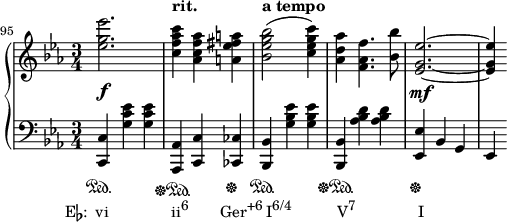
Back Übermäßiger Quintsextakkord German Aŭgmentita kvintsesta akordo EO Sixte augmentée French Accordo di sesta eccedente Italian 増六の和音 Japanese 증6화음 Korean 增六和弦 Chinese

A German sixth chord on the last beat of m. 96 in Scott Joplin's "Binks' Waltz" (1905).[1]
In music theory, an augmented sixth chord contains the interval of an augmented sixth, usually above its bass tone. This chord has its origins in the Renaissance,[2] was further developed in the Baroque, and became a distinctive part of the musical style of the Classical and Romantic periods.[3]
Conventionally used with a predominant function (resolving to the dominant), the three most common types of augmented sixth chords are usually called the Italian sixth, the French sixth, and the German sixth.
- ^ Benward, Bruce and Saker, Marilyn (2009). Music in Theory and Practice, Vol. II, p.105. Eighth edition. McGraw Hill. ISBN 9780073101880.
- ^ Andrews 1950, pp. 45–46.
- ^ Andrews 1950, pp. 46–52.